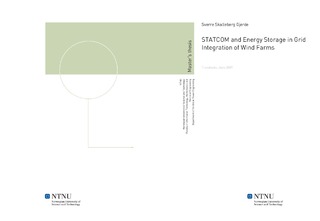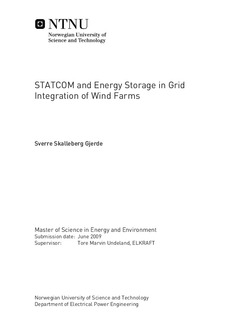| dc.description.abstract | In this work, a STAtic synchronous COMpensator (STATCOM) with energy storage system for wind power application has been treated. This device was proposed as a mean to improve voltage stability and power transmission by offering reactive as well as active power compensation. The work focuses on the converter topology of the STATCOM part and the control system. Further on, the energy storage system needed for this application was designed, including the choice of energy storage, its size and the interface/control system. The STATCOM, reactive part of the compensator was based on a voltage source converter (VSC), using a vector control. Its purpose was to maintain a stable grid voltage. For active compensation of wind power, a bank of super capacitors for energy storage system, SCESS, was used in this thesis. The super capacitor bank size was estimated, based upon the short term fluctuations in wind power. These fluctuations are results of contstructional factors of the turbines, variations and turbulence in the wind. The super capacitor bank was interfaced with the DC-bus of the STATCOM with a normal half-bridge buck-boost converter, to control the voltage level of the bank while maintaing a constant DC-bus voltage for good switching operation in the VSC. The control system for the active power compensation part was implented as a cascaded PI-control, compromising an inner current control loop, and an outer power control loop. The outermost loop included a dynamical power reference, based on the actual power transfer in the grid. This reference is supposed to assure that the controller is only compensating small fluctuations, while larger changes are left for other means, for instance controlled hydro power. The designed system was implemented in EMTDC/PSCAD. A small model, including one wind turbine, a weak grid and the STATCOM/SCESS was used in the simulations. With regards to the reactive- and active power compensation, the results were promising. However, the dynamical power reference could be of a better quality, as it does not take into account the losses in the STATCOM/SCESS, and thereby is inacurate regarding the amount power fed to/from the super capacitor bank. In addition, a small STATCOM model was realised in the laboratory. The results from the practical work showed the same general patterns as the simulations. | nb_NO |

